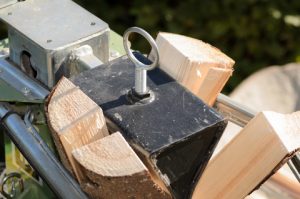Enhance Wood Processing with Blacktrac Tractor Log Splitters
In the world of wood processing, efficiency is key. Whether you’re a smallholding owner managing your own woodlot, a forestry professional overseeing large-scale operations, or a DIY enthusiast tackling weekend projects, the right tools can make all the difference. Among these tools, tractor log splitters stand out as powerful allies in the quest for productivity. This guide will explore how to maximise efficiency with tractor log splitters, empowering you to streamline your wood processing tasks and achieve optimal results.
Tractor log splitters have revolutionised the way we process wood. Gone are the days of laborious manual splitting, replaced by machines that harness the power of hydraulics or your tractor’s PTO (Power Take-Off) to make quick work of even the toughest logs. The benefits of using a tractor log splitter are numerous, but two stand out above the rest: significant time savings and dramatically increased productivity.
By integrating a log splitter into your workflow, you can process more wood in less time, freeing you up for other tasks or simply allowing you to complete your wood processing duties more quickly. This efficiency boost isn’t just about convenience; it can translate into real economic benefits for professionals and significant time savings for hobbyists and homeowners.
Understanding Tractor Log Splitters
Before diving into efficiency techniques, it’s crucial to understand the basics of tractor log splitters. These machines come in two main varieties: hydraulic and PTO-powered.
Hydraulic log splitters use the tractor’s hydraulic system to power a ram that pushes logs against a wedge, splitting them apart. These are often simpler to operate and can be more versatile, as they can sometimes be used independently of the tractor.
PTO-powered log splitters, on the other hand, connect directly to your tractor’s PTO shaft. They use the rotational energy from the PTO to power a hydraulic pump, which in turn drives the splitting mechanism. These tend to be more powerful and efficient, especially for larger-scale operations.
Regardless of the type, all log splitters share some common components:
- The beam or rail: This is the main body of the splitter, providing a stable platform for the log.
- The wedge: This sharp, angled piece of metal is what actually splits the log.
- The ram: This pushes the log against the wedge.
- The hydraulic system: This provides the power to move the ram.
- Controls: These allow you to operate the splitter safely.
Understanding these components and how they work together is crucial for maximising your splitter’s efficiency and ensuring safe operation.
Choosing the Right Log Splitter for Your Needs
Selecting the appropriate log splitter is a critical step in maximising efficiency. The two primary factors to consider are tonnage and compatibility with your tractor.
Tonnage refers to the amount of force the splitter can exert. This is typically measured in tonnes, with common ranges being 20-30 tonnes for home use and 30–60 tonnes for professional applications. The right tonnage depends on the type and size of wood you’ll be processing. Hardwoods like oak or maple require more force than softwoods like pine. Similarly, larger-diameter logs need more tonnage than smaller ones.
As a general rule,
| Usage Type | Wood Type and Size | Recommended Tonnage |
| Occasional Home Use | Smaller, softer logs | 20-25 tonnes |
| Regular Mixed Use | Various wood types | 25-35 tonnes |
| Professional Use | Large, hardwood logs | 35+ tonnes |
Matching the log splitter to your tractor’s capabilities is equally important. For PTO-powered splitters, ensure your tractor can provide the necessary RPM (usually around 540 RPM) and horsepower. For hydraulic splitters, check that your tractor’s hydraulic system can deliver the required flow rate and pressure.
Remember, bigger isn’t always better. An oversized splitter can be less efficient and more difficult to manoeuvre. Strike a balance between power and practicality for optimal efficiency.
Setting Up Your Tractor Log Splitter
Proper setup is crucial for both efficiency and safety. Here’s a step-by-step guide to attaching and preparing your log splitter:
- Position your tractor on level ground and engage the parking brake.
- If using a PTO-powered splitter, ensure the PTO is disengaged before connecting.
- Align the splitter’s hitch with your tractor’s drawbar and secure it properly.
- For PTO splitters, carefully attach the PTO shaft, ensuring it’s locked in place.
- If using a hydraulic splitter, connect the hydraulic lines to your tractor’s remote hydraulic outlets.
- Check all connections and ensure the splitter is stable before operation.
Safety precautions during setup are paramount:
- Always wear appropriate Personal Protective Equipment (PPE), including gloves and safety glasses.
- Never position yourself between the tractor and the splitter during attachment.
- Double-check all connections before operation.
- Ensure the area is clear of bystanders before starting up.
Maximising Efficiency with Your Log Splitter
Once your splitter is set up, several techniques can help you maximise efficiency:
- Proper log placement: Position logs so that natural cracks or grain patterns align with the wedge. This reduces the force needed to split the wood.
- Optimal operating speed: Find the right balance between speed and power. Operating too quickly can lead to incomplete splits, while going too slowly wastes time.
- Use a log lift: For larger operations, a log lift can save significant time and energy in loading logs onto the splitter.
- Implement a sorting system: Have a plan for where the split wood will go. This prevents bottlenecks in your workflow.
- Maintain consistent power: For PTO-powered splitters, maintain a steady engine RPM for consistent splitting power.
- Work in teams: If possible, have one person operate the splitter while another loads and removes split wood.
- Choose the right time: Split wood when it’s freshly cut or during colder months when the wood is drier and splits more easily.
Common issues that can reduce efficiency include:
- Dull wedges: Regularly sharpen or replace your splitter’s wedge.
- Hydraulic leaks: Check and maintain seals to prevent power loss.
- Improper log size: Trying to split logs that are too large for your machine will slow you down.
Maintenance Tips for Long-Term Efficiency
Regular maintenance is key to keeping your log splitter operating at peak efficiency:
- Lubrication: Regularly grease all moving parts, especially the wedge and beam.
- Hydraulic fluid: Check levels regularly and replace as recommended by the manufacturer.
- Blade sharpening: Keep the wedge sharp for easier splitting.
- Tighten bolts: Vibration can loosen bolts over time. Check and tighten regularly.
- Clean after use: Remove wood debris to prevent damage and rust.
- Store properly: Keep your splitter in a dry, covered area when not in use.
Troubleshooting common problems:
- If the ram moves slowly or lacks power, check hydraulic fluid levels and look for leaks.
- If the wedge gets stuck in a log, don’t force it. Retract the wedge and reposition the log.
- For PTO splitters, unusual noises could indicate problems with the shaft or pump. Cease operation and inspect carefully.
When in doubt or for major repairs, always consult a professional. Trying to fix complex issues yourself can lead to further damage or safety risks.
Safety Best Practices
Safety should always be your top priority when operating a tractor log splitter. Here are some key safety practices:
- Personal Protective Equipment (PPE):
- Wear safety glasses to protect your eyes from wood chips.
- Use hearing protection, especially with louder PTO-powered splitters.
- Wear sturdy work gloves to protect your hands.
- Steel-toed boots provide foot protection from falling logs.
- Safe log handling:
- Never try to split logs larger than your machine is rated for.
- Always grip logs from the sides, never the ends.
- Keep your workspace clear of split wood and debris.
- Machine operation:
- Never reach into the splitting area while the machine is operating.
- Keep bystanders, especially children, well away from the work area.
- Never attempt to clear a jammed log while the splitter is running.
- Emergency procedures:
- Know how to quickly shut off your splitter in case of an emergency.
- Keep a first-aid kit nearby.
- Have a plan for how to call for help if needed.
- Regular safety checks:
- Inspect hydraulic lines for wear or damage before each use.
- Check that all guards and safety features are in place and functioning.
- Ensure the splitting wedge is securely attached and not damaged.
- Operator training:
- Anyone who will be using the splitter should be thoroughly trained in its operation and safety procedures.
- Regular refresher training can help maintain safe practices over time.
Maximising efficiency with a tractor log splitter involves a combination of choosing the right equipment, using proper techniques, maintaining your machinery, and prioritising safety. By following the tips and best practices outlined in this guide, you can significantly boost your wood processing productivity while ensuring a safe working environment.
Choose Blacktrac Compactors today!
Discover the power of efficiency with Blacktrac Compactors. Our range of robust, high-performance compactors and log splitters is designed to meet the demanding needs of various industries. But we offer more than just equipment; we’re your partners in productivity. Explore our comprehensive workshops, where you can gain hands-on experience and expert insights. Our tailored services ensure your compactors perform at their peak, maximising your return on investment. Don’t settle for less when it comes to compaction solutions. Reach out to Blacktrac today and let our team of specialists guide you towards the perfect compactor for your needs. Your next level of efficiency is just a call or click away!












